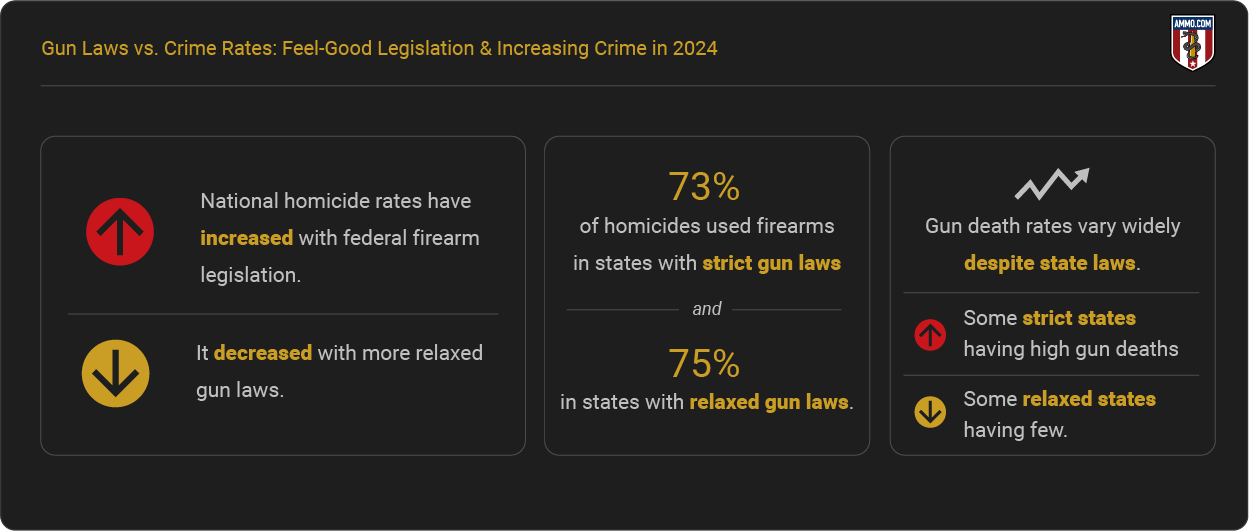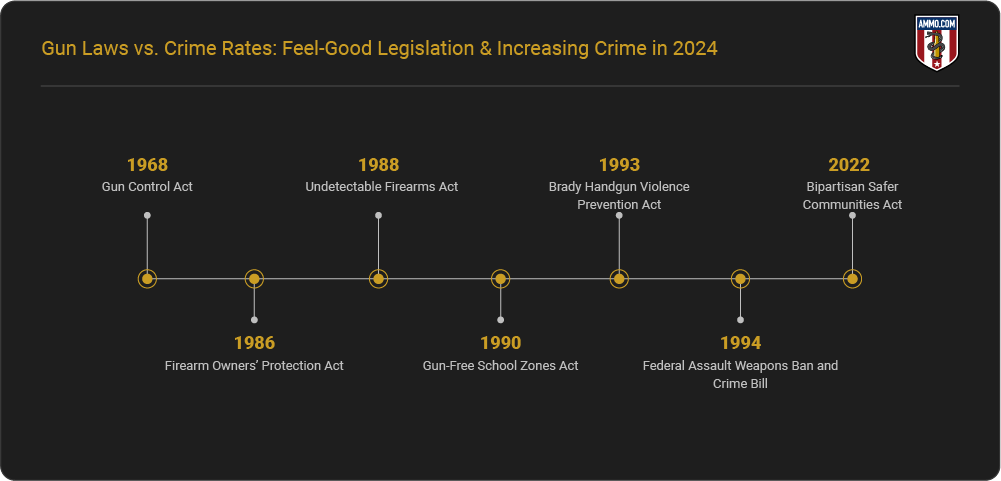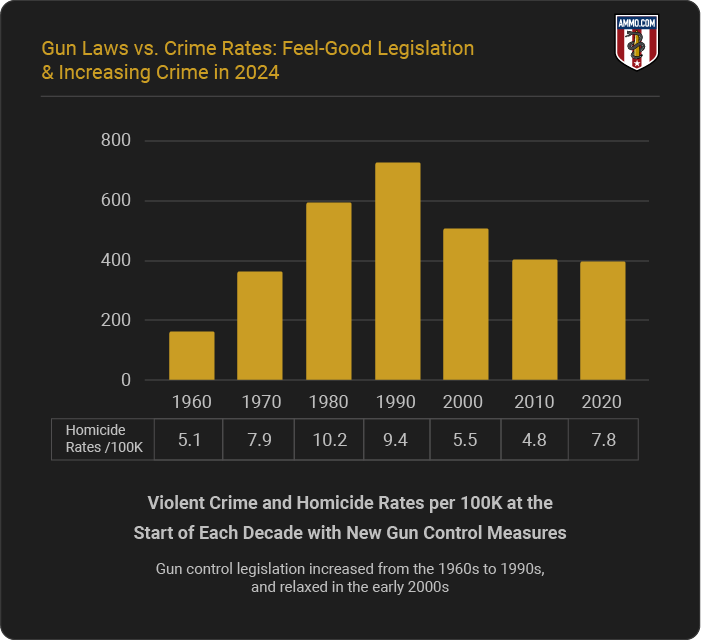Gun Laws vs. Crime Rates in 2024: A Comprehensive Analysis
Almost daily, legislators propose new gun laws aimed at reducing crime rates. However, both new and existing laws are unlikely to impact crime significantly. With over 90 years of gun control legislation and crime data, it's clear that these laws do little to curb criminality or save lives.
While some countries with strict gun laws have low crime rates, others do not. Additionally, strict gun laws in safer countries have saved few lives over the past two decades.
This article examines the effects of gun legislation on criminality, homicide, and mass shootings.
National homicide rates have increased with federal firearm legislation and decreased with more relaxed gun laws.
Firearms are used in 73% of homicides in states with strict gun laws and 75% in states with relaxed gun laws.
Gun death rates vary widely despite state laws, with some strict states having high gun deaths and some relaxed states having few.

You can see a comprehensive list of our sources for this article here.
Do Strict Gun Laws Reduce Violent Crime?
With thousands of active gun laws in the U.S., homicide rates have reached levels not seen since 1993. Despite media and gun lobby claims, “common sense” gun legislation is neither common sense nor productive.
Federal firearm legislation began in 1934. To understand its impact, we can review crime rates over the past 91 years.
Exploring Gun Laws and Crime Rates: A Historical Perspective
We have over nine decades of crime rates and gun control laws to review. Here are some major federal gun regulations:

The 1930s: Crime and Guns
Gun laws have been a temporary solution for crime for nearly a century. However, crime rates often increased after new restrictive legislation, particularly in the 1930s.
Prohibition, which aimed to reduce crime, created a new market for criminality. Illegal alcohol production and distribution led to higher homicide and crime rates. After Prohibition ended in 1933, the National Firearms Act was passed in 1934, banning firearms associated with criminality.
Homicide rates rose from 1.3 per 100,000 people in 1904 to 9.6 per 100,000 in 1934. Despite various contributing factors, the homicide rate never dropped below 4 per 100,000 again.
The 1960s and 1970s: Crime and Guns
Before the 1968 Gun Control Act, violent crime rates were lower. Despite more unrestricted access to firearms, the 1960 crime rate was 160.9 incidents per 100,000 people. Crime rates increased steadily from 1964, peaking in 1991 at 758.2 per 100,000 people, with homicide rates rising from 5 to 8.8 per 100,000 from 1960 to 1970.
The 1968 Gun Control Act aimed to restrict firearm transfers to felons and those with mental illnesses. Despite its intentions, crime rates quadrupled over the next three decades.
Subsequent legislation, like the 1986 Firearm Owners’ Protection Act and the 1993 Brady Handgun Violence Prevention Act, failed to reduce crime significantly.
The 1980s and 1990s: Crime and Guns
The 1980s and 1990s were the most violent decades in American history. Homicide rates in 1980 were 10.9 per 100,000 people, and violent crime rates rose from 500 to over 700 per 100,000.
The 1993 Brady Handgun Violence Prevention Act mandated national background checks and waiting periods, but homicide and violent crime rates remained high. Crime rates only began to decline after 1994, attributed to the 1994 Violent Crime Control and Law Enforcement Act, not the Federal Assault Weapons Ban.
The 1994 FAWB didn’t ban all semi automatic rifles, only those with detachable magazines and a few other features found only on rifles. Assault weapons weren’t being used often in violent crimes and homicides before the legislation took place. Violent crime did not increase after the FAWB expired in 2004. Had the FAWB been effective, these three facts could not be true, and yet they are.
Incarceration rates rose by 59% after the 1994 Crime Bill, while crime decreased by 22%. Homicide rates did not increase again until 2016, when softer crime policies became more popular.
If we look beyond our borders, El Salvador dropped their country’s homicide rates from 53.3 per 100k to only 2.4 per 100k after opening supermax prisons and incarcerating gang members.
Essentially, the increases and decreases in crime through the 1990s can largely be attributed to crime policies and incarceration rates rather than any gun control legislation in Congress.

Do Strict Gun Laws Reduce Mass Shootings?
One of the more common talking points regarding gun control is that we need to implement new policies to reduce mass shootings. However, mass shootings and school shootings were incredibly rare before sweeping federal gun control legislation.
Prior to 1984, mass shootings were so infrequent most people today aren’t even aware they happened. However, the United States has experienced at least one mass shooting every year since the 1986 Firearm Owners’ Protection Act prohibited the possession and transfer of machine guns, as well as tightened restrictions on gun sellers.
Although Congress passed many gun control bills between 1986 and 1994, mass shootings became more frequent.
There were seven mass shootings in the United States between 1970 and 1979. This number doubled between 1980 and 1989 with 14 mass shootings. Between 1990 and 1999, there were 29 mass shootings. 2000 to 2009 saw 41 mass shootings and 66 mass shootings between 2010 and 2020 (not including gang violence or family-related shootings).
Overall, mass shootings were less frequent when individuals could purchase machine guns without background checks from pawn shop dealers than they are with dozens of “common sense” gun laws now.
Guns and Crime: International Comparisons
Many countries with strict gun control or outright bans still experience high crime rates. For instance, the U.K., Australia, and Canada had low homicide rates before implementing gun bans, and these countries also report high violent crime rates.
- The U.K. reported 2.1 million violent crimes against a person in 2023, compared to 1.2 million in the U.S.
- Australia reported 123 rapes per 100,000 people, while the U.S. reported 40 per 100,000 in 2023.
- Canada reported 1,364 violent crimes per 100,000 people in 2022, compared to 380.7 per 100,000 in the U.S.
The U.S. has a homicide rate of 6.8 per 100,000 people in 2023, with over 400 million firearms. In contrast, Mexico, with only 16 million firearms and strict gun laws, has a homicide rate of 26 per 100,000. Honduras, with background checks and training requirements, has 800,000 firearms and a homicide rate of 35 per 100,000.
Despite gun bans, the U.K. and Australia still experience mass shootings and homicides, albeit at lower rates than the U.S. The U.K.’s homicide rate dropped from 1.5 per 100,000 before 1997 to 1 per 100,000 nearly three decades later. Similarly, Australia’s rate fell from 1.94 to 0.74 per 100,000 after mandatory buybacks.
The Future of Gun Laws and Crime in America
Despite the evidence, politicians and the gun control lobby continue pushing for more regulations, such as Red Flag Laws, Universal Background Checks, and Safe Storage Laws. However, these laws will not save lives in America.
The answer lies in enforcing existing laws and implementing tough crime policies, which have proven effective, while restrictive legislation has shown adverse effects.
Sources
- The 1994 FAWB
- 1986 FOPA
- Brady Handgun Violence Prevention Act (1993/1994)
- Hospitalizations
- Firearm Trace Data
- Firearm Mortality
- BJS Report Crime Guns
- Homicide Rates El Salvador
- Mass Shootings in the U.S.
- Violent Crime Rates in the U.S.
- Violent Crimes in the U.K.
- Australia Crime Stats
- Murder Rate by Country
- Civilian Owned Firearms by Country
Infographics
- Are Guns & Ammo The New Gold? Why More Americans Are Arming Themselves
- The Greatest Gun Salesman In America: President Barack Obama
- Shooting Straight: How Both Presidential Candidates Have Changed On Gun Control
- President Obama: (Still) The Greatest Gun Salesman in America
- An Inconvenient Truth: How The Obama Administration Became Earth's Largest Arms Dealer
- Armed Drones: President Obama's Weapon of Choice
- COVID-19 Data Study: Ammunition Sales Continue to Soar in Response to Coronavirus Panic
- Data Study: 18 Months of Ammo Sales during a Pandemic, Protests, and the Biden Presidency
- Data Study: U.S. Ammo Sales Surge Following Russian Invasion of Ukraine
- Most Gun-Friendly States in 2024
- Worst States to be a Gun Owner (2024 Updated)
- Children & Firearms: Definitions and Demographics Make All the Difference
- Urban Violent Crime & Legal Gun Ownership
- Gun-Free School Zone Laws & School Shootings (2024 Updated)
- Gun Control Laws and Enforcement Trends 2024
- Gun Ownership by State (2024 Statistics)
- How Many Gun Owners are in America? (2024 Statistics)
- Concealed Carry Crime Stats 2024
- Accidental Shooting Statistics: A Review of Unintentional Firearm Deaths from 1979-2024
- America’s Stolen Guns: A Silent Contributor to Gun Crimes in the U.S. (2024)
- Gun Violence Statistics 2024: Comprehensive Look at the Data
- Gun Laws vs. Crime Rates in 2024: A Comprehensive Analysis
- Gun Death Statistics by Caliber: A Review of Calibers and Crime in 2024
- Anti-Gun Control Arguments 2024: Facts Gun Control Lobby Suppress
- Guns in the Home Statistics: The Effects of Firearms in the Home in 2024
- Gun Deaths in the US: Analyzing At-Risk Demographics in 2024
- How Many Guns in the U.S.: All About America’s Firearms in 2024
- Gun Facts in the U.S. 2024: The Reality of Firearms in America
- Defensive Gun Use Statistics: America’s Life-Saving Gun Incidents (2024)
- Correlation Between Mass Shootings and Prescription Drugs (2024 Study)
- Gun Ownership by Gender in 2024: Closing the Gender Gap
- Murders by Weapon Type: September 2024 Statistics
- Gun Violence Among Black Americans: September 2024 Statistics
- The Ultimate Hunting Caliber Chart: Best Cartridge Per Species
- How Old Do You Have to be to Buy a Gun: A State Guide 2024
- Most Popular Guns in the U.S.: The Must-Have Guns in 2024
- Stray Bullet Deaths: Accident and Injury Statistics in September 2024
- Mass Shooters by Race: Demographics of Assailants 1966-2024
- Ammunition Limits By State in 2024: How Much Ammo Can You Buy?
- Why Do Americans Own Guns in 2024?
- How Many Americans Want Stricter Gun Laws in 2024?
- How Many Households in the U.S. Have a Gun in 2024?
- What Percentage of Gun Deaths are Suicides in 2024?
- Average Age of Mass Shooters in the U.S.
- Firearm Ownership in America by Year
- US Firearms Deaths Per Year: A Collective Report 1968-2024
- Percentage of Americans Owning Guns in 2024
- Texas Gun Ownership: Total Numbers, Trends, and Most Popular Guns
- Gun Ownership Statistics Colorado 2025: Trends & Numbers
- Hunting Accident Statistics 2025 (Causes & Trends Per Year)
- Banned Guns & Ammo List: A 2025 Review by State
- 3D Printed Gun Laws By State
- How To Build a Home Shooting Range: The Ultimate Guide
- States With the Highest Murder Rates
- Best Self-Defense Weapons for Women
